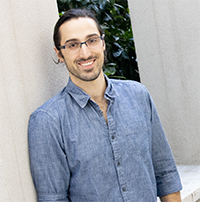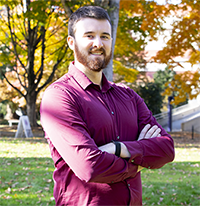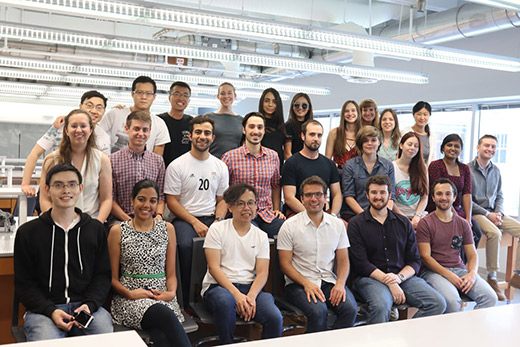Since opening his Emory lab in 2009, Khalid Salaita, associate professor in the Department of Chemistry and PhD program faculty in Chemistry and Biomedical Engineering, has used nanotechnology to understand the physical forces that cells exert as they interact with one another.
Now, through the power of mentorship, Aaron Blanchard (BME), Joshua Brockman (BME) and Victor Ma (Chemistry), have taken knowledge gained from their training in Salaita’s lab to study cancer through the National Cancer Institute’s Predoctoral to Postdoctoral Fellowship Transition Award. The program has a rigorous and highly competitive selection process—that Salaita’s lab has produced three fellows speaks volumes about the exciting nature of his group’s work and his commitment to doctoral education.
The fellowship has two phases: the predoctoral phase (F99) helps predoctoral fellows complete their dissertation research training, and the postdoctoral phase (K00) allows post-doctoral fellows to work with mentors in cancer-focused research positions. Ma, Blanchard, and Brockman are in different stages of their fellowships.
Victor Ma
Ma received the grant in the fall of 2017 and, after completing his PhD in Chemistry in the summer of 2019, entered the postdoctoral phase of the fellowship at Harvard Medical School’s Brigham and Woman’s Hospital. While at Harvard, Dr. Ma and his mentor, professor of medicine Dr. Jeffery Karp, will focus on developing biomaterials that can be used to treat cancer.
Ma’s F99 project centered around the field of “mechano-immunology,” in which he studied an adhesion receptor called LFA-1 that helps T cells attach themselves to other cells. “I aimed to unravel how T cells use mechanical forces to enable their biochemical signaling and function,” explains Ma. “The techniques that I learned during my early years in Salaita’s lab prepared me to ask questions from a unique perspective.”
The techniques that Ma and his lab mates use are based on DNA nanotechnology. In 2014, Salaita’s lab started looking into this technology to study how DNA can be manipulated into nanostructures that could detect and produce the tiny forces (or piconewtons) cells exert on one another.
“We started thinking of DNA not as a molecule to carry information but as a molecule that can also be used to apply these piconewton forces,” Salaita explained. “We coined a new term, which is DNA mechano-technology.”
Aaron Blanchard

Salaita and current fifth-year graduate student Aaron Blanchard worked on a paper submitted to the journal Science that highlights the different uses of DNA mechano-technology. The techniques developed in the lab have many uses for the NCI fellowship. “Cancer cells exhibit a lot of unique mechanical properties,” Blanchard said. “A big part of how tumors are able to grow is that they create their own specific physical environment…”
Blanchard, who is studying biomedical engineering, received his grant in 2019 and is exploring how cancer cells become more equipped to invade other cells. For his NCI project, Blanchard proposed to do an experiment using DNA nanotechnology that studies how the outer layer of cancer cells makes them better at invading tissues within the body. He will then construct a model that explains the phenomenon.
For Blanchard, the funding from the grant will give him more space to pursue innovation and to develop new skill sets.
“I’m really stoked about it,” Blanchard said. “I feel like the opportunity to do scientific research is such a great gift—and to receive funding to do so is so awesome.”
Joshua Brockman

Brockman is studying biomedical engineering in the joint program between Emory and the Georgia Institute of Technology. While studying as an undergrad at Ohio State University, Brockman became fascinated with the concept of cells working mechanically. When he entered graduate school, Salaita’s lab gave him the ability to explore the field of mechano-biology even further.
Brockman’s F99 project, which he started in 2018, focused on measuring the direction in which cell receptors were tugging on the DNA-based force sensors. In turn, he developed the molecular force microscopy technique. Brockman’s new F99 project aims to increase the resolution of molecular force microscopy. In the long run, he hopes to use the NCI fellowship to start pushing biologists to meld the mechanical and chemical aspects of cell biology.
“I’m really proud of this because, for an academic, intellectual contribution is what you’re hoping to achieve,” Brockman said. “When I entered [Salaita’s] lab, he had done a lot of the conceptual heavy lifting…but this technique—this new thing—It’s my baby. I was there when it was born.”
All three of Salaita’s mentees attributed their progress as researchers to Salaita’s guidance. He is known to give his students the necessary freedom to be innovative as they engage in their research. While Salaita acknowledges the drawbacks to this approach, he recognizes its merits.
“I think we, as in academia, underestimate how much graduate students can achieve,” Salaita said. “While my role is to direct students to the really big problems that we’d love to solve, I also like students to go at it on their own and think of creative solutions to solving those problems.”
Salaita encourages all his students to seek out opportunities for programs like the NCI Fellowship. Whether they are looking for letters of support or simply applying to fellowship programs, Salaita helps them to look past the perceived barriers of being accepted.
“Oftentimes, the number of applicants is much lower than expected,” Salaita said. “You’re definitely not going to get it unless you try.”
Salaita is excited about what his next crop of students will bring to the table once his current students have finished their graduate programs. For him, the journey with graduate students, is one of the most rewarding aspects of being a mentor.
“We both learn along the path,” Salaita said. “The beauty is that you would never have anticipated how remarkably they’d grow to be five years earlier.”


